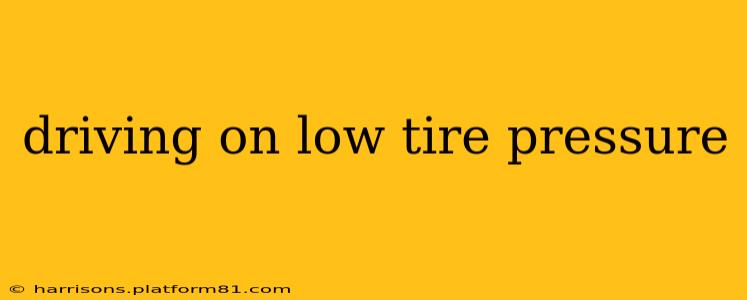Driving on low tire pressure is more dangerous than many drivers realize. It significantly impacts your vehicle's handling, fuel efficiency, and can even lead to tire failure. This comprehensive guide explores the risks, causes, and solutions associated with driving on underinflated tires.
What Happens When You Drive on Low Tire Pressure?
Driving with underinflated tires leads to a cascade of negative consequences. The tire's sidewalls flex excessively, generating more heat and friction. This increased heat can weaken the tire's structure, leading to premature wear and tear and even a blowout. Furthermore, the reduced contact patch between the tire and the road diminishes traction, making your vehicle harder to control, especially in wet or icy conditions.
How Does Low Tire Pressure Affect Fuel Economy?
Underinflated tires increase rolling resistance. This means your engine has to work harder to maintain speed, resulting in significantly reduced fuel efficiency. You'll likely notice a drop in your gas mileage if you're consistently driving on low tire pressure. The exact impact varies depending on the severity of the underinflation and the vehicle, but it can be substantial.
What are the Signs of Low Tire Pressure?
Several indicators can alert you to low tire pressure. The most obvious is a low tire pressure warning light on your dashboard. However, you might also notice:
- A visibly deflated tire: Obvious flattening is a clear sign.
- Changes in vehicle handling: The car might feel sluggish, pull to one side, or feel unstable.
- Increased vibration: You might feel unusual vibrations through the steering wheel or the vehicle's body.
- Faster tire wear: Uneven or excessive wear on your tires can be a sign of prolonged low tire pressure.
How Often Should I Check My Tire Pressure?
Regular tire pressure checks are crucial for safety and fuel efficiency. Experts generally recommend checking your tire pressure at least once a month, or before any long journey. Remember to check the pressure when the tires are cold (before driving).
What is the Correct Tire Pressure for My Car?
The correct tire pressure for your vehicle isn't a universal number. You'll find the recommended pressure listed in your owner's manual or on a sticker located inside the driver's side doorjamb, or on the fuel filler door. This pressure is usually expressed in PSI (pounds per square inch). Remember that the recommended pressure might vary depending on the load you're carrying.
Can I Drive on Low Tire Pressure for a Short Distance?
While you might be tempted to drive on slightly low tire pressure for a short distance, it's generally not advisable. Even short distances can generate enough heat to damage the tire, especially at higher speeds. It's best to inflate your tires to the correct pressure as soon as possible.
What Causes Low Tire Pressure?
Low tire pressure can stem from several factors:
- Slow leaks: Punctures, valve stem issues, or general wear and tear can cause slow leaks.
- Temperature changes: Cold weather can cause a slight drop in tire pressure.
- Improper inflation: Not inflating tires to the correct pressure during routine checks.
What Should I Do if I Have a Flat Tire?
If you suspect a flat tire, pull over to a safe location away from traffic. Engage your hazard lights. Change the flat tire with your spare, or call for roadside assistance if you're uncomfortable changing a tire yourself. Remember to inflate the spare to the correct pressure as indicated on its sidewall or in your owner's manual.
Can I Repair a Tire with Low Pressure?
Whether you can repair a low-pressure tire depends on the cause. A slow leak might be repairable by a tire professional, but a significant puncture or damage to the sidewall will require tire replacement. Never attempt complex repairs yourself.
By understanding the risks and taking proactive steps to maintain proper tire pressure, you can significantly enhance your safety and extend the life of your tires. Remember, your tires are your vehicle's connection to the road, so keeping them properly inflated is paramount.
